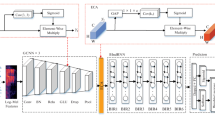Abstract
We propose a novel approach for semi-supervised learning (SSL) designed to overcome distribution shifts between training and real-world data arising in the keyword spotting (KWS) task. Shifts from training data distribution are a key challenge for real-world KWS tasks: when a new model is deployed on device, the gating of the accepted data undergoes a shift in distribution, making the problem of timely updates via subsequent deployments hard. Despite the shift, we assume that the marginal distributions on labels do not change. We utilize a modified teacher/student training framework, where labeled training data is augmented with unlabeled data. Note that the teacher does not have access to the new distribution as well. To train effectively with a mix of human and teacher labeled data, we develop a teacher labeling strategy based on confidence heuristics to reduce entropy on the label distribution from the teacher model; the data is then sampled to match the marginal distribution on the labels. Large scale experimental results show that a convolutional neural network (CNN) trained on far-field audio, and evaluated on far-field audio drawn from a different distribution, obtains a 14.3% relative improvement in false discovery rate (FDR) at equal false reject rate (FRR), while yielding a 5% improvement in FDR under no distribution shift. Under a more severe distribution shift from far-field to near-field audio with a smaller fully connected network (FCN) our approach achieves a 52% relative improvement in FDR at equal FRR, while yielding a 20% relative improvement in FDR on the original distribution.
Access this chapter
Tax calculation will be finalised at checkout
Purchases are for personal use only
Similar content being viewed by others
Notes
- 1.
Also known as keyword spotting; this is a task of detecting keywords of interest in a continuous audio stream.
References
Arjovsky, M., Bottou, L., Gulrajani, I., Lopez-Paz, D.: Invariant risk minimization. arXiv preprint arXiv:1907.02893 (2019)
Bachman, P., Alsharif, O., Precup, D.: Learning with pseudo-ensembles. Adv. Neural Inf. Process. Syst. 27 (2014)
Berthelot, D., Carlini, N., Goodfellow, I., Papernot, N., Oliver, A., Raffel, C.: Mixmatch: a holistic approach to semi-supervised learning. In: NeurIPS (2019)
Chelba, C., Acero, A.: Adaptation of maximum entropy capitalizer: little data can help a lot. Comput. Speech Lang. 20(4), 382–399 (2006)
Chen, G., Parada, C., Heigold, G.: Small-footprint keyword spotting using deep neural networks. In: 2014 IEEE International Conference on Acoustics, Speech and Signal Processing (ICASSP), pp. 4087–4091. IEEE (2014)
Elsahar, H., Gallé, M.: To annotate or not? Predicting performance drop under domain shift. In: Proceedings of the 2019 Conference on Empirical Methods in Natural Language Processing and the 9th International Joint Conference on Natural Language Processing (EMNLP-IJCNLP), pp. 2163–2173 (2019)
Fernndez, S., Graves, A., Schmidhuber, J.: An application of recurrent neural networks to discriminative keyword spotting. In: Artificial Neural Networks-ICANN, pp. 220–229 (2007)
Gao, Y., et al.: On front-end gain invariant modeling for wake word spotting. arXiv preprint arXiv:2010.06676 (2020)
Geirhos, R., Rubisch, P., Michaelis, C., Bethge, M., Wichmann, F.A., Brendel, W.: ImageNet-trained CNNs are biased towards texture; increasing shape bias improves accuracy and robustness. ICLR (2019)
Grandvalet, Y., Bengio, Y.: Semi-supervised learning by entropy minimization. Adv. Neural Inf. Process. Syst. 17 (2004)
Jose, C., Mishchenko, Y., Senechal, T., Shah, A., Escott, A., Vitaladevuni, S.: Accurate detection of wake word start and end using a CNN. In: Interspeech (2020)
Krueger, D., et al.: Out-of-distribution generalization via risk extrapolation (rex). arXiv preprint arXiv:2003.00688 (2020)
Kumar, R., Rodehorst, M., Wang, J., Gu, J., Kulis, B.: Building a robust word-level wakeword verification network. In: Interspeech (2020)
Lee, D.H., et al.: Pseudo-label: the simple and efficient semi-supervised learning method for deep neural networks. In: Workshop on Challenges in Representation Learning, ICML, vol. 3, p. 896 (2013)
Panchapagesan, S., et al.: Multi-task learning and weighted cross-entropy for DNN-based keyword spotting. In: Interspeech (2016)
Parisi, G.I., Kemker, R., Part, J.L., Kanan, C., Wermter, S.: Continual lifelong learning with neural networks: a review. Neural Netw. 113, 54–71 (2019)
Parthasarathi, S.H.K., Strom, N.: Lessons from building acoustic models with a million hours of speech. In: ICASSP 2019–2019 IEEE International Conference on Acoustics, Speech and Signal Processing (ICASSP), pp. 6670–6674. IEEE (2019)
Quionero-Candela, J., Sugiyama, M., Schwaighofer, A., Lawrence, N.D.: Dataset Shift in Machine Learning. The MIT Press (2009)
Recht, B., Roelofs, R., Schmidt, L., Shankar, V.: Do ImageNet classifiers generalize to ImageNet? In: Proceedings of the 36th International Conference on Machine Learning, pp. 5389–5400 (2019)
Ruder, S., Plank, B.: Strong baselines for neural semi-supervised learning under domain shift. arXiv preprint arXiv:1804.09530 (2018)
Sainath, T.N., Parada, C.: Convolutional neural networks for small-footprint keyword spotting. In: Interspeech (2015)
Sajjadi, M., Javanmardi, M., Tasdizen, T.: Regularization with stochastic transformations and perturbations for deep semi-supervised learning. Adv. Neural Inf. Process. Syst. 29 (2016)
Shalev, G., Adi, Y., Keshet, J.: Out-of-distribution detection using multiple semantic label representations. In: Advances in Neural Information Processing Systems (NeurIPS) (2018)
Sun, M., et al.: Compressed time delay neural network for small-footprint keyword spotting. In: Interspeech (2017)
Tucker, G., Wu, M., Sun, M., Panchapagesan, S., Fu, G., Vitaladevuni, S.: Model compression applied to small-footprint keyword spotting. In: Proceedings of Interspeech (2016)
Zhang, C., Bengio, S., Hardt, M., Recht, B., Vinyals, O.: Understanding deep learning requires rethinking generalization. ICLR (2017)
Zhao, X., Krishnateja, K., Iyer, R., Chen, F.: Robust semi-supervised learning with out of distribution data. arXiv preprint arXiv:2010.03658 (2020)
Author information
Authors and Affiliations
Corresponding author
Editor information
Editors and Affiliations
Rights and permissions
Copyright information
© 2022 Springer Nature Switzerland AG
About this paper
Cite this paper
Parthasarathi, S.H.K., Zeng, L., Jose, C., Wang, J. (2022). Wakeword Detection Under Distribution Shifts. In: Sojka, P., Horák, A., Kopeček, I., Pala, K. (eds) Text, Speech, and Dialogue. TSD 2022. Lecture Notes in Computer Science(), vol 13502. Springer, Cham. https://doi.org/10.1007/978-3-031-16270-1_26
Download citation
DOI: https://doi.org/10.1007/978-3-031-16270-1_26
Published:
Publisher Name: Springer, Cham
Print ISBN: 978-3-031-16269-5
Online ISBN: 978-3-031-16270-1
eBook Packages: Computer ScienceComputer Science (R0)




